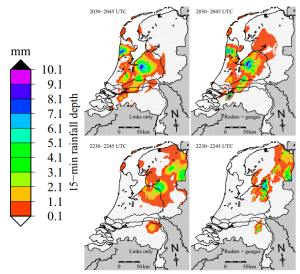Mobile masts measure rainfall

Space-time dynamics of 15 min rainfall depths (two panels per time step) from links (left) and radar s plus gauges (right) for September 10, 2011, 2030–2045 and 2230–2245 hours UTC.
Traditionally rainfall has been measure by low tech rain gauges that simply measure the height of rainfall in a certain area. But these need to be manually placed across a large area and individually read. Because of these requirements, the number of in-place rain guages has been rapidly falling in recent years. Other methods include using radar absorption but mobile phone signal has the significant advantage in that it’s much more widespread across most countries.
Using mobile phone radio waves was first tried out in 2006. Scientists from the University of Tel Aviv published in renowned journal Science claiming that their technique proved to be more accurate that measurements used by normal weather services. They found that rain is particularly good at weakening the strength of electromagnetic waves meaning it’s perfect for being measured by mobile signal strength. Usually mobile phone masts already use this information to automatically boost signal strength when they notice rainfall or other causes has produced a drop in coverage.
The Netherlands was a perfect country to test in as although it is quite small at approximately 35,000 square kilometres, it has about 2,400 mobile phone masts linked together to provide valuable data. The test were conducted on T-Mobile’s masts over two 12 day periods and the scientists were able to generate real-time rainfall data from their readings. The novel method has proved its value and may well turn out to be even more useful in countries with a good mobile phone network but more meteorological infrastructure.





